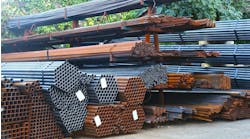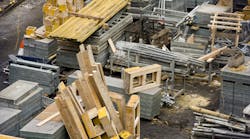Latest from Construction Data
Sponsored
WASHINGTON, DC — More contractors are facing a shortage of building materials as the pandemic continues, according to new fourth quarter data from the U.S. Chamber of Commerce Commercial Construction Index (Index). This quarter, 41% of contractors say less availability of building products and materials is a severe consequence of the pandemic, up from just 15% saying the same in Q3.
Most (71%) contractors say they face at least one material shortage, up 17 points from 54% in Q3. The most reported material shortage is wood/lumber, which has seen higher demand from a boom in residential construction during the pandemic. Now, 31% of commercial construction contractors report a shortage of lumber, up 20 points from 11% last quarter. Of those contractors experiencing shortages, 89% say it is having a moderate to high level of impact on their business, up from 75% saying so last quarter.
Despite growing concern over materials shortages, the overall Index score this quarter rose slightly to 60, up from 57 in Q3. All three of the Index’s main indicators rose: Contractors’ confidence in new business opportunities over the next year inched up one point to 57, revenue expectations increased four points to 52, and backlog rose two points to 70. Despite the gains, the Index remains significantly below the score of 74 from the first quarter of 2020 before the pandemic.
“The pandemic has exacerbated issues contractors were already facing in availability and cost of materials from tariffs and a shortage of skilled workers,” said U.S. Chamber of Commerce Executive Vice President and Chief Policy Officer Neil Bradley. “But there’s reason for optimism. More than one in three contractors plan to hire more workers in the next six months, and most see sufficient new business in the coming year.”
“The industry is a positive indicator of where the rest of the economy is going, but it’s likely confidence won’t fully return until companies and workers have the confidence to get back to work safely,” Bradley added. “That’s why the U.S. Chamber is urging lawmakers to come together before the end of the year on additional pandemic relief.”
Contractor Confidence Rises
Despite ongoing uncertainty over the future of commercial construction, contractors signal that they are cautiously optimistic about their medium to long term prospects. Most (85%) report a moderate to high level of confidence in the construction market to provide enough new business in the next 12 months, up from 83% in Q3, and up 10 points from 75% in Q2.
While the majority (61%) of contractors expect their revenue to remain about the same over the next year, more (25%) expect an increase, up from 22% in Q3, and fewer (14%) expect a decrease, down from 19% in Q3. Additionally, 20% of contractors expect to see profit margins increase over the next year, compared to 17% last quarter.
Material Costs Concerns Remain High
More contractors (36%) plan to spend more on tools and equipment in the next six months, up from 30% in Q3, but concern about fluctuations in the cost of building materials remains high. Most (74%) contractors indicate cost fluctuations have a moderate to high impact on their business, up 11 points from 63% in Q3.
Of those who said the fluctuations have a considerable impact, 61% said wood/lumber is the product of most concern, up from 21% in Q3, followed by steel (30%). Meanwhile, a quarter (24%) of contractors say steel and aluminum tariffs will have a high degree of impact on their business in the next three years, although this is down from 29% in Q1, and from 40% in Q4 2019.
Additional findings:
- A shortage of skilled labor is creating challenges. Most (83%) contractors report moderate to high levels of difficulty finding skilled workers. Of those, 83% are asking skilled workers to do more work, 71% report struggling to meet schedule requirements, and 39% are turning down work.
- Contractors are more decisive on hiring plans. More contractors (37%) indicate they plan to employ more people over the next six months, up five points from 32% in Q3. Meanwhile, 12% expect to reduce their staffing, also up five points from 7% in Q3.
- 83% of contractors are experiencing project delays due to COVID-19. Contractors report the average share of delayed projects is 26%. Looking ahead six months, that drops to 18%.
- 64% say worker health and safety remains a top concern for their business, followed by more project shutdowns/delays (53%), and less availability of building products and materials (41%).
The Index comprises three leading indicators to gauge confidence in the commercial construction industry, generating a composite Index on the scale of 0 to 100 that serves as an indicator of health of the contractor segment on a quarterly basis.
The Q4 2020 results from the three key drivers are:
- Backlog: This indicator increased by two points to 70 (from 68 in Q3).
- New Business Confidence: The overall level of contractor confidence increased to 57 (up one point from Q3).
- Revenue: Contractors’ revenue expectations over the next 12 months increased to 52 (up 4 points from Q3).
The research was developed with Dodge Data & Analytics (DD&A), the leading provider of insights and data for the construction industry, by surveying commercial and institutional contractors.
The U.S. Chamber of Commerce Commercial Construction Index is a quarterly economic index designed to gauge the outlook for, and resulting confidence in, the commercial construction industry. The U.S. Chamber produces this Index, along with Dodge Data & Analytics (DD&A). Each quarter, researchers from DD&A source responses from their Contractor Panel of more than 2,700 commercial construction decision-makers in order to better understand their levels of confidence in the industry and other key trends. This panel allows DD&A to provide findings that are representative of the entire U.S. construction industry by geography, size, and type of company.
Visit www.CommercialConstructionIndex.com to access the full report, methodology, and shareable graphics.


